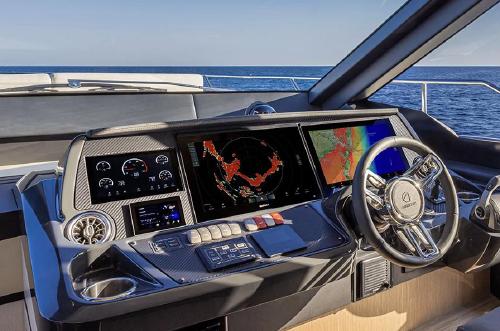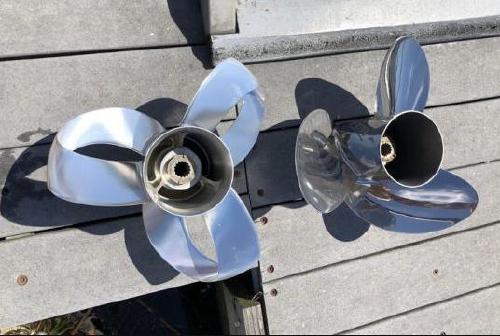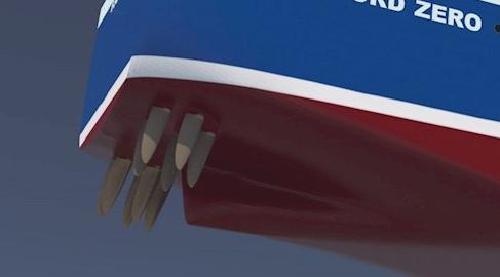Rolls-Royce pod drives aren’t just for massive cruise ships anymore. These quiet underwater propulsion units have been quietly reshaping everything from polar icebreakers to mega-yachts, offering precision, efficiency, and surprising design freedom along the way. You may not see them on your average sportfishing boat, but if you’re into ship engineering, futuristic yachts, or just like knowing what’s spinning under the hull—this tech is worth getting familiar with.
Let’s dive into what these things actually are, how they work, and where they’re heading.

What Is a Pod Drive, Exactly?
In regular boat propulsion, you’ve got a shaft running from the engine to the propeller. The prop spins, the rudder steers, and that’s that. It works, but it’s not super compact, and you need a lot of hardware inside the hull.
A pod drive, on the other hand, puts everything—motor, shaft, gearbox, and propeller—into a single rotating unit that hangs below the hull. It steers by turning the entire pod like a swivel, which eliminates the need for a separate rudder.
The most well-known setup is azimuthing, meaning it can spin 360° to push the boat in any direction. This makes them ridiculously good at docking, station-keeping, and handling big ships in tight harbors.
Rolls-Royce has been in the pod game for a while, producing various systems like:
- Azipull: Pull-type pods for low-drag applications
- Azipod (licensed with ABB): Widely used in ice-class vessels
- Promas: Propeller + rudder efficiency combo (not technically a pod, but similar goals)
Who Actually Uses These?
Rolls-Royce pod drives aren’t something you slap onto a pontoon boat. We’re talking serious hardware here. You’ll find them on:
- Icebreakers navigating the Arctic
- Research vessels like the Sir David Attenborough
- 100m+ explorer yachts
- Large ferries and hybrid-electric cruise ships
- Some experimental unmanned surface vessels (USVs)
They’re also starting to creep into the luxury yacht scene as more builders switch to diesel-electric propulsion for range, silence, and layout flexibility.
Why Use a Pod Drive?
Let’s break down what makes these pods so appealing to engineers, captains, and ship designers:
1. Ridiculous Maneuverability
Since the entire unit rotates, you can crab sideways, spin on a dime, or station-keep in rough water without thrusters.
2. Fuel Efficiency
Pods are usually paired with electric motors. That means fewer mechanical losses and more flexibility in how you generate power—think hybrid diesels, batteries, or LNG.
3. Lower Noise
Because the motor is isolated outside the hull, there’s less vibration and noise in the cabin areas.
4. Space Saving
No long shafts, couplings, or giant gearboxes inside. That frees up space for cabins, storage, or engineering spaces.
5. Easier Modular Design
Electric pods play well with modern ship designs where you want redundancy and separated power generation (like having multiple gensets instead of one big diesel engine).
Technical Specs (Azipull Example)
Here’s a snapshot of what a typical Rolls-Royce Azipull pod offers:
| Feature | Azipull 85C |
|---|---|
| Power Output | 5 MW (~6,700 hp) |
| Max Rotation | 360° azimuthing |
| Motor Type | Permanent magnet electric |
| Propeller | Pull-type, 4-blade, fixed pitch |
| Installation Depth | ~2.8 m below keel |
| Vessel Types | Ferries, yachts, research vessels |
| Fuel Efficiency Gain | 10–15% over traditional shaft/rudder |
If you need to break ice, the Azipod VI series is ice-class certified, with reinforced pods and special blade geometry to chew through frozen sea like it’s a slushie.
What Do They Cost?
These things aren’t exactly off-the-shelf. Pricing is usually baked into the ship’s engineering contract, but based on public tenders and industry reports, you’re looking at:
| Model | Power Range | Price (USD) | Price (CAD) |
|---|---|---|---|
| Azipull 85C | ~5 MW | $3.2–3.8 million | $4.4–5.3 million |
| Azipod VI-M | ~7.5 MW | $4.5–5.5 million | $6.2–7.6 million |
| Promas Retrofit | N/A | $750k–1.2 million | $1.0–1.6 million |
These prices exclude the diesel-electric setup, gensets, batteries, and installation labor. For a full twin-pod system on a 100m yacht, the propulsion portion alone could hit $10 million USD easily.
What’s It Like to Operate One?
For the captain, it’s joystick heaven. You can literally spin the boat around its center point or slide sideways toward a dock.
These systems usually include:
- Joystick or touchscreen interface
- Dynamic Positioning (DP) integration
- Auto-heading and autopilot features
- Redundancy modes (if one pod fails, the other still runs)
But not everyone loves them right away. Captains used to rudders and shafts sometimes take a bit to adapt to joystick handling—it’s more like flying a drone than driving a bus.
Are These Pods Reliable?
Overall, yes—but they’re not maintenance-free. Rolls-Royce pod drives have built-in condition monitoring, which means the ship knows when something’s off (overheating bearing, noisy gear mesh, etc.).
Common maintenance tasks include:
- Gear oil changes every 2,000–5,000 hours
- Seal inspections during haul-outs
- Blade replacement after damage or fatigue
- Software updates (yes, like firmware for a boat)
Dry-docking is still necessary every few years, and you’ll want specialized techs for most repairs. This isn’t a DIY job.

What About for Smaller Boats?
That’s where things get interesting. While Rolls-Royce isn’t dropping pods into 30-footers, the same azimuthing electric drive concept is trickling down into smaller commercial boats.
There are now electric pod drives in the 100–300 kW range showing up on:
- Hybrid harbor ferries
- Electric water taxis
- Sustainable tour boats
- Zero-emissions workboats
Rolls-Royce’s MTU division is developing smaller modular propulsion systems under its hybrid platform, which means we might see “mini-pods” in smaller yachts within a few years—especially in Europe.
Real-World Vessels with Rolls-Royce Pods
Here are a few ships you can stalk online that use RR pods:
- RRS Sir David Attenborough – Ice-class research ship with twin Azipods
- Havila Castor – Hybrid-electric cruise ship with pods and battery banks
- Lürssen 120m Yacht Project – Rumored twin Azipull installation
- Yamal LNG Tankers – Triple pod configurations for Arctic navigation
These vessels operate in some of the toughest environments on Earth—from Arctic ice to tropical ports—and that says a lot about the reliability of the system.
So, Is This the Future?
Pods aren’t going to replace every shaft-drive vessel anytime soon. For small and mid-size boats, the cost and complexity just don’t make sense yet. But for anything:
- Over 40 meters
- Needing hybrid or electric drive
- Requiring insane maneuverability
…pod drives are already winning the argument.
They’ll become more common as more ships move toward hybrid, battery-assisted, and LNG power. The layout flexibility alone makes them a favorite for naval architects, and regulators like the IMO love them for fuel savings.
Disclaimer: All technical specifications, prices, and vessel examples in this article are based on publicly available information and typical industry ranges. Prices are approximate as of mid-2025 and may vary depending on project scope, location, and shipyard installation costs. Always consult an authorized Rolls-Royce Marine representative for up-to-date information.



Use the share button below if you liked it.